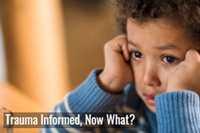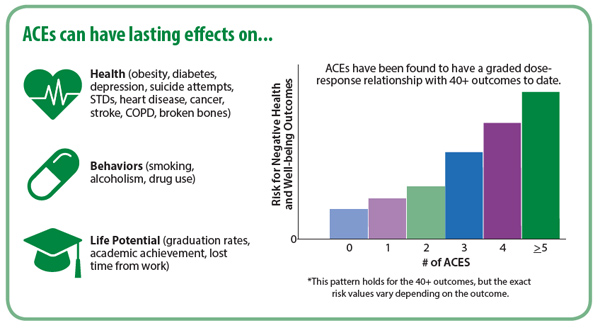Trauma Informed, Now What?
Overview 
What are Adverse Childhood Experiences and How Do They Impact Students?
In Preventing ACES – Leveraging the Best Available Evidence, the Centers for Disease Control and Prevention (CDC) describes Adverse Childhood Experiences, or ACEs, as the potentially traumatic events that occur in childhood (0-17 years) such as experiencing violence, abuse, or neglect; witnessing violence in the home; and having a family member attempt or die by suicide. Additional components of a child’s environment can undermine their sense of safety, stability, and bonding; these include such things as experiencing discrimination or racism, growing up in a household with substance misuse, mental health problems, or instability due to parental separation or incarceration of a parent, sibling or other member of the household. Traumatic events in childhood can be emotionally painful or distressing and can have effects that persist for years. Factors such as the nature, frequency and seriousness of the traumatic event, prior history of trauma, and available family and community supports can shape a child’s response to trauma.

The "Pair of ACES" Tree, shown below, depicts the interrelationship of adverse childhood experiences and adverse childhood environments on health and wellbeing.

CDC has identified the following 6 strategies for preventing ACEs and reducing their deleterious effects. Schools have a role with each strategy.

Action to Become Trauma-Informed and Responsive
Traumatized 5-year-olds are three times more likely to have problems with paying attention, and two times more likely to show aggression (NEA), and students with two or more ACEs are three times more likely to repeat a grade (SAMHSA). Trauma changes children’s brains, affects their academic advancement, and has broader impacts. The following resources are provided to support educators in improving the social and emotional, health and academic outcomes of students who have experienced trauma.
Information and Training
Severe stress affects students. Understanding this is the foundation for creating trauma sensitive classrooms.
- How childhood trauma affects health across a lifetime | Nadine Burke Harris - YouTube
- Understanding Trauma: Learning Brain vs Survival Brain - YouTube
- Trauma-Informed E-Learning Course: Introduction (Lesson 1 of 13) - YouTube
- Child Trauma Toolkit for Educators | The National Child Traumatic Stress Network
- Understanding the Traumatized Child
- ACE Interface Master Trainer Program – Virginia Department of Behavioral Health and Developmental Services developed an infographic on the impact of ACEs on Virginia’s youth. For more information on trainings being held by ACE Master Trainers in Virginia contact Keith Cartwright, Behavioral Health Wellness Consultant at the Virginia Department of Behavioral Health and Developmental Services
Ways to Address and Reduce Trauma among Your Students
Schools can create inclusive, welcoming, healing experiences for all students, especially critical for those students who have experienced trauma:
- Why We Need Trauma-Sensitive Schools - YouTube
- Creating, Supporting, and Sustaining Trauma-Informed Schools: A System Framework | The National Child Traumatic Stress Network
- Cognitive Behavioral Intervention for Trauma in Schools program is a school-based, group and individual intervention. It is designed to reduce symptoms of post-traumatic stress disorder (PTSD), depression, and behavioral problems, and to improve functioning, grades and attendance, peer and parent support, and coping skills. CBITS has been used with students from 5th grade through 12th grade who have witnessed or experienced traumatic life events such as community and school violence, accidents and injuries, physical abuse and domestic violence, and natural and man-made disasters. CBITS uses cognitive-behavioral techniques (e.g., psychoeducation, relaxation, social problem solving, cognitive restructuring, and exposure).
- Mental Health - Trauma Sensitive Schools | Wisconsin Department of Public Instruction
- School Health Policy to Address Trauma
- Stress Trauma and the Brain / Insights for Educators
- Teen Sports May Protect Victims Of Childhood Trauma From Depression, Anxiety : Shots - Health News : NPR
- TSA | Guidelines for developing a trauma-informed school
- Trauma Informed Approaches to Classroom Management
- Trauma-Informed Schools | Ohio Department of Education
- Trauma-Informed Schools – Information Brief
- Trauma-Sensitive Schools: A Whole-School Approach - Trauma Sensitive Schools
- Safe Supportive Learning
- TSA | Support for trauma-informed schools and resources for traumatic stress
- Unlocking the Door to Learning – Trauma Informed Classrooms and Transformational Schools
- Witnessing Overdose: What Youth Say or Do vs What they Think and Feel and How to Help
Social Emotional Learning Resources
A full section on Social Emotional Health Resources and grade level lessons and instructional resources are available on Health Smart Virginia. Resources related to the COVID-19 Pandemic are also included.
- Supporting SEL is a Trauma Informed Practice (Committee for Children)
- Trauma Informed Schools and Social-Emotional Learning
- Social Emotional Learning Resources during COVID-19-CASEL, The Collaborative for Academic, Social, and Emotional Learning (CASEL): Provides resources and information on the coronavirus and planning for parents and caregivers, educators, and state leaders and policymakers (CASEL Resource Library).
Mental Health Resources
Mental health awareness, training, and support services are essential components of trauma-informed and trauma-responsive schools. Refer to Health Smart Virginia’s What is Mental Health? - Mental Health Wellness Training, Education, and Resources section for more information.
Additionally, with studies identifying the impact of the COVID-19 epidemic on student mental health, and with schools struggling to provide mental health services, as a result of the resulting reduced in-person contact, numerous virtual mental health resources have been curated:
- Partnership to End Addiction Virtual Recovery Resources for Families
- SAMHSA Virtual Recovery Resources List
- Resources to Support Adolescent Mental Health

